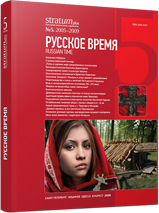Трилистные фибулы в Пруссии
A Trefoil Fibula in Prussia
Author(s): Vladimir Ivanovich KulakovSubject(s): History, Middle Ages, 6th to 12th Centuries
Published by: Издательский дом Stratum, Университет «Высшая антропологическая школа»
Keywords: Trefoil Fibula; Prussia; Vikings’ time; Kleeblattfibeln; Scandinavian antiquities; Kaup
Summary/Abstract: In Northeuropean antiquities of the Vikings’ time, trefoil fibula (Kleeblattfibeln) is one of the rarest decorations. These items are characterized by unique outlines of a trefoil flower. The examples of such fibulae found in burial grounds have from 44.3 to 69.5 mm in diameter. Known basically from the Scandinavian antiquities of 9th – early 10th centuries, the given fasteners are extremely rare in the East Europe and in the Baltic region. Reportedly, in 1967 on the territory of Ancient Russia only 8 finds of trefoil fibulae were documented. The number of these finds apparently had not increased by the early 2000.In 2000, the Baltic expedition of the Institute of Archeology of the Russian Sciences Academy resumed its activities started in 1979 on a complex archaeological site dated by the Vikings’ time and located in a forested natural boundary at Kaup (Kaliningrad). The structure of this complex, alongside with the discovered trading and industrial settlement, known since 1979, includes a burial ground of 9th-11th centuries. It was left by the multiethnic population of the Kaup settlement. Works on this burial ground have yielded three finds of the rare for the Baltic region trefoil fibula.
Journal: Stratum plus. Археология и культурная антропология
- Issue Year: 2009
- Issue No: 5
- Page Range: 243-248
- Page Count: 6
- Language: Russian
- Content File-PDF

